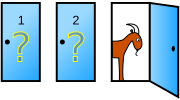In a double-whammy of sad news, we’ve learned of the passing of two mathematical figures, famous for very different reasons – fields medalist Vladimir Voevodsky, and gameshow creator and host Monty Hall.

CC-BY-SA from Wikipedia; Image by Renate Schmid
Vladimir Voevodsky, winner of the 2002 Fields Medal, was based at the Institute for Advanced Studies at Princeton. His prize was awarded due to his work “defining and developing motivic cohomology and the A1-homotopy theory of algebraic varieties; he proved the Milnor conjectures on the K-theory of fields”.
Described by his colleagues at the IAS as “a truly extraordinary and original mathematician”, Voevodsky worked mainly in algebraic topology, geometry and K-theory. More recently his work had turned to type-theoretic formalisations of mathematics, and formal proof-checking programmes.
Originally from Moscow, Vladimir Voevodsky gained a degree from Moscow State University in 1989, and a PhD from Harvard in 1992. He died on 30th September at the age of 51 – and sadly he’s not even the first Fields medalist to pass away this year. He will be deeply missed at the IAS, and a formal gathering to celebrate his life is being planned.

Monty Hall in the 1970s
Monty Hall was not a mathematician, but co-created the game show ‘Let’s Make a Deal’, which inspired an interesting and counterintuitive probability result which mathematicians have found it difficult to explain. While the exact scenario involved never actually took place as part of the show, the problem has become known as the Monty Hall problem due to show’s format, which included a choice of prizes which were hidden from contestants until they had chosen.
Imagine a game show contestant is offered a choice of three doors, behind two of which are goats and one a car. Once they’ve chosen a door, one of the other two doors opened and revealed to contain a goat. The contestant may then choose to stick with their original choice, or switch to the remaining door.

Even though it’s known that one of the two remaining doors has a goat and one a car, so the probability of wining feels like it should be equal if you stick or switch, it’s actually better to switch, and switching will lead to you winning 2/3 of the time.
The Monty Hall problem was famously written about by Marilyn Vos Savant in her column in Parade Magazine in 1990, and many readers rudely wrote in to complain that she was wrong, as the probability must be 50-50 – but she was correct, and continued to insist so across several columns. Vos Savant suggested schools nationwide conduct trials to determine the frequency, and received many positive replies from teachers and research departments. Gradually, people came round and realised she had been right from the start.
As well as co-creating ‘Let’s Make a Deal’, Monty Hall had a long career in game shows, and became well-known for his extensive charity work. His agent announced that he died of heart failure at the age of 96.
More information
Vladimir Voevodsky, Fields Medalist, Dies at 51, on the IAS website
Monty Hall, co-creator and host of “Let’s Make a Deal,” dead at 96, on CBS News